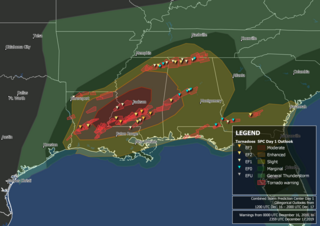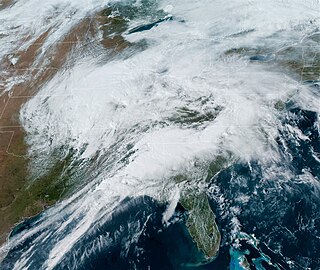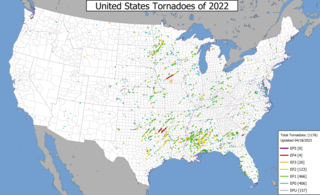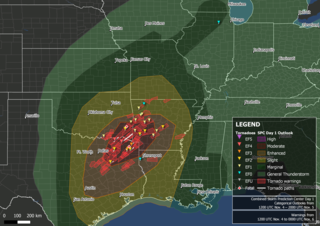
On March 2 and 3, 2012, a deadly tornado outbreak occurred over a large section of the Southern United States into the Ohio Valley region. The storms resulted in 41 tornado-related fatalities, 22 of which occurred in Kentucky. Tornado-related deaths also occurred in Alabama, Indiana, and Ohio. The outbreak was the second deadliest in early March for the U.S. since official records began in 1950; only the 1966 Candlestick Park tornado had a higher death toll for a tornadic system in early March.

This page documents notable tornadoes and tornado outbreaks worldwide in 2015. Strong and destructive tornadoes form most frequently in the United States, Bangladesh, Brazil and Eastern India, but they can occur almost anywhere under the right conditions. Tornadoes also develop occasionally in southern Canada during the Northern Hemisphere's summer and somewhat regularly at other times of the year across Europe, Asia, and Australia. Tornadic events are often accompanied with other forms of severe weather including strong thunderstorms, winds and hail.

On December 23, 2015, an outbreak of supercell thunderstorms produced tornadoes across northern Mississippi and middle Tennessee, resulting in 13 tornado-related deaths and numerous injuries. Other tornadoes occurred as far north as Indiana and Michigan. Scattered tornado activity continued over the next two days before the outbreak ended. This was the first of two deadly tornado outbreaks to impact the southern United States during December 2015 with the other occurring just a day after this one ended.

This page documents notable tornadoes and tornado outbreaks worldwide in 2016. Strong and destructive tornadoes form most frequently in the United States, Bangladesh, Brazil and Eastern India, but they can occur almost anywhere under the right conditions. Tornadoes also develop occasionally in southern Canada during the Northern Hemisphere's summer and somewhat regularly at other times of the year across Europe, Asia, and Australia. Tornadic events are often accompanied with other forms of severe weather, including strong thunderstorms, strong winds, and hail.

This page documents notable tornadoes and tornado outbreaks worldwide in 2017. Strong and destructive tornadoes form most frequently in the United States, Brazil, Bangladesh, and Eastern India, but they can occur almost anywhere under the right conditions. Tornadoes also develop occasionally in southern Canada during the Northern Hemisphere's summer and somewhat regularly at other times of the year across Europe, Asia, Argentina and Australia. Tornadic events are often accompanied with other forms of severe weather, including strong thunderstorms, strong winds, and hail.

The tornado outbreak of February 28 – March 1, 2017 was a widespread and significant outbreak of tornadoes and severe weather that affected the Midwestern United States at the end of February 2017 and beginning of March. Fueled by the combination of ample instability, strong wind shear, and rich low-level moisture, the event led to 71 confirmed tornadoes and thousands of other non-tornadic severe weather reports. The most notable aspect of the outbreak was a long-tracked EF4 tornado—the first violent tornado of 2017 and the first violent tornado during the month of February since the 2013 Hattiesburg, Mississippi tornado—that tracked from Perryville, Missouri to near Christopher, Illinois, killing one person. Three EF3 tornadoes were recorded during the event, including one that caused two fatalities in Ottawa, Illinois, one that caused a fatality near Crossville, and one that heavily damaged or destroyed homes in and around Washburn. In addition to the deaths, 38 people were injured by tornadoes and an additional 30 were injured by non-tornadic impacts, mainly by fallen trees.

This page documents notable tornadoes and tornado outbreaks worldwide in 2019. Strong and destructive tornadoes form most frequently in the United States, Argentina, Brazil, Bangladesh, and Eastern India, but can occur almost anywhere under the right conditions. Tornadoes also develop occasionally in southern Canada during the Northern Hemisphere's summer and somewhat regularly at other times of the year across Europe, Asia, Argentina, and Australia. Tornadic events are often accompanied by other forms of severe weather, including strong thunderstorms, strong winds, and hail.

A significant severe weather and tornado outbreak affected the Southern United States between December 16–17, 2019. Discrete supercells developed in the early morning on December 16 and moved northeast, spawning multiple strong, long-tracked tornadoes in cities such as Alexandria and in Laurel before congealing into an eastward-moving squall line. During the outbreak, the National Weather Service issued several PDS tornado warnings as well as a rare tornado emergency for Alexandria. In addition to this, the Storm Prediction Center issued six tornado watches for the outbreak. The event happened to take place on the same date of another outbreak in a similar area 19 years earlier.

This page documents notable tornadoes and tornado outbreaks worldwide in 2020. Strong and destructive tornadoes form most frequently in the United States, Argentina, Brazil, Bangladesh, and eastern India, but can occur almost anywhere under the right conditions. Tornadoes also develop occasionally in southern Canada during the Northern Hemisphere's summer and somewhat regularly at other times of the year across Europe, Asia, Argentina, Australia and New Zealand. Tornadic events are often accompanied by other forms of severe weather, including strong thunderstorms, strong winds, and hail.

A small but deadly tornado outbreak affected West and Middle Tennessee on the night of March 2 and into the morning of March 3, 2020, including a high-end EF3 tornado that hit Nashville and Mount Juliet, becoming the 6th costliest tornado in United States history, and a violent EF4 tornado that impacted areas in and just west of Cookeville. A total of 25 people were killed by the tornadoes, with an additional 309 being injured, and more than 70,000 lost electricity. The path of the Nashville tornado was very similar to the one that hit East Nashville in 1998. A few additional tornadoes were also confirmed in Alabama, southeastern Missouri, and western Kentucky. Total damage from the event reached $1.607 billion according to the National Centers for Environmental Information.

A widespread and deadly tornado outbreak affected the Southeastern United States on Easter Sunday and Monday, April 12–13, 2020. Several tornadoes were responsible for prompting tornado emergencies, including the first one to be issued by the National Weather Service in Charleston, South Carolina. A large squall line formed and tracked through the mid-Atlantic on April 13, prompting more tornado warnings and watches. A total of 15 watches were produced during the course of the event, two of which were designated Particularly Dangerous Situations.

This page documents notable tornadoes and tornado outbreaks worldwide in 2021. Strong and destructive tornadoes form most frequently in the United States, Argentina, Brazil, Bangladesh, and Eastern India, but can occur almost anywhere under the right conditions. Tornadoes also develop occasionally in southern Canada during the Northern Hemisphere's summer and somewhat regularly at other times of the year across Europe, Asia, Argentina, Australia and New Zealand. Tornadic events are often accompanied by other forms of severe weather, including strong thunderstorms, strong winds, and hail.

A significant tornado outbreak sequence took place from March 24–28, 2021 in the Southern United States just one week after another outbreak affected similar regions. There were 43 tornadoes confirmed across 11 states, with the bulk of activity primarily on March 25, which resulted in the Storm Prediction Center (SPC) issuing its second high-risk outlook for the month of March, as well as the second high-risk outlook for 2021. Several intense tornadoes touched down on that day, including ones that prompted the issuance of rare tornado emergencies near Hoover, Alabama, Brent and Centreville, Alabama, and in the Newnan, Georgia area. March 27 also saw widespread tornado activity mainly across East Texas, Southern Arkansas, Louisiana, and Western Tennessee with several strong tornadoes touching down. Scattered to widespread wind and hail damage occurred throughout the outbreak sequence, and repeated rounds of heavy rain caused widespread severe flash and river flooding across much of Tennessee.

A deadly late-season tornado outbreak, the deadliest on record in December, produced catastrophic damage and numerous fatalities across portions of the Southern United States and Ohio Valley from the evening of December 10 to the early morning of December 11, 2021. The event developed as a trough progressed eastward across the United States, interacting with an unseasonably moist and unstable environment across the Mississippi Valley. Tornado activity began in northeastern Arkansas, before progressing into Missouri, Illinois, Tennessee, and Kentucky.

This page documents notable tornadoes and tornado outbreaks worldwide in 2022. Strong and destructive tornadoes form most frequently in the United States, Argentina, Brazil, Bangladesh, and Eastern India, but can occur almost anywhere under the right conditions. Tornadoes also develop occasionally in southern Canada during the Northern Hemisphere's summer and somewhat regularly at other times of the year across Europe, Asia, Argentina, Australia and New Zealand. Tornadic events are often accompanied by other forms of severe weather, including strong thunderstorms, strong winds, and hail.

A significant late-season tornado outbreak took place on November 4, 2022, across Northeast Texas, southwestern Arkansas, southeastern Oklahoma, and northwestern Louisiana with multiple large, destructive tornadoes occurring over a span of several hours. Major damage was reported in Sulphur Springs, Powderly, Caviness, Paris, Cason, Daingerfield, Athens, New Boston, Texas, and Idabel, Oklahoma, with the latter two communities being placed under tornado emergencies. Two fatalities occurred in Cason, Texas, and Pickens, Oklahoma respectively. Numerous PDS tornado warnings were issued as well. An additional tornado embedded within a narrow, but intense line of showers with damaging winds was also confirmed in Illinois the following morning as the system progressed eastward. Strong winds affected most of the western Great Lakes throughout the day before moving into Canada that evening. Two fatalities and at least 34 injuries were confirmed from tornadoes, and an additional fatality occurred near Stilwell, Oklahoma from drowning.

This page documents notable tornadoes and tornado outbreaks worldwide in 2023. Strong and destructive tornadoes form most frequently in the United States, Argentina, Brazil, Bangladesh, and Eastern India, but can occur almost anywhere under the right conditions. Tornadoes also develop occasionally in southern Canada during the Northern Hemisphere's summer and somewhat regularly at other times of the year across Europe, Asia, Argentina, Australia and New Zealand. Tornadic events are often accompanied by other forms of severe weather, including thunderstorms, strong winds, and hail.

An early-season tornado outbreak impacted the Southeastern United States on January 12, 2023. The result of a mid-level trough moving through, moisture and the presence of a strong low-level jet aided in the development of numerous severe and tornadic thunderstorms. Early in the outbreak, a strong EF2 tornado caused considerable damage in Winston County, Alabama, while another EF2 tornado struck just south of Greensboro. A destructive high-end EF2 tornado struck Selma, causing widespread damage and two injuries. The same storm produced a long-lived EF3 tornado that moved through or near Old Kingston, Titus, Equality, and Lake Martin, resulting in seven fatalities and several injuries in Autauga County alone. Another EF2 tornado from the storm struck areas in or around Five Points and Standing Rock before crossing into Georgia. After the dissipation of that tornado, nine more tornadoes, five of which were strong, caused heavy damage across west-central Georgia, especially in LaGrange, Griffin, and Experiment, the second one of which was impacted by four tornadoes in the span of 10 minutes, including two that were rated EF2 and EF3 respectively. Another EF2 tornado from the storm caused major damage and another fatality in the Jackson Lake area as well; an indirect death from the tornado also occurred the following day. Elsewhere, other tornadoes caused damage in Sumter and Mobile counties in Alabama, as well as parts of Mississippi, Tennessee, Kentucky, Illinois, and the Carolinas. In all, 41 tornadoes were confirmed.

On March 24, 2023, a severe weather and tornado outbreak began across portions of the lower Mississippi River Valley in the United States. A slow-moving trough moved eastward across the United States and interacted with a moist and unstable airmass originating from the Gulf of Mexico, resulting in widespread heavy rainfall, severe thunderstorms, and significant tornadoes over a four-day period. A violent high-end EF4 tornado moved through the towns of Rolling Fork, Midnight, and Silver City in western Mississippi, causing catastrophic damage and many fatalities. Multiple tornado emergencies were issued for that tornado and two subsequent EF3 tornadoes from the same supercell that struck Winona and Amory.

A widespread, deadly, and historic tornado outbreak affected large portions of the Midwestern, Southern and Eastern United States on the last day of March and the first of April, the result of an extratropical cyclone that also produced blizzard conditions in the Upper Midwest. The Storm Prediction Center (SPC) issued a rare high risk for severe weather in two areas of the Mississippi Valley on March 31, the first high risk issuance since March 25, 2021. Approximately 28 million people were placed under tornado watches, including multiple PDS tornado watches, from the evening of March 31 through the overnight hours into the morning of April 1. This included the Little Rock, St. Louis, Chicago, and Memphis metropolitan areas, all of which were hit by multiple rounds of severe squall lines and supercell thunderstorms that produced damaging winds, large hail, and tornadoes. EF3 tornadoes in Arkansas, Tennessee, and Illinois prompted the issuance of tornado emergencies and multiple mass casualty incidents were declared for some of the hardest hit areas. One of these tornadoes was a high-end EF3 tornado that passed through the northern Little Rock metro, causing extensive damage and dozens of injuries. The strongest tornado was a low-end EF4 tornado that swept away homes on the west side of Keota, Iowa. Severe and tornadic weather also affected the Northeastern United States in the afternoon and evening of April 1, including a rare EF3 tornado that caused a death in Sussex County, Delaware. At certain points of the outbreak, over 20 simultaneous tornado warnings were active, with a total of 175 tornado warnings issued on March 31 with an additional 51 issued on April 1.

























